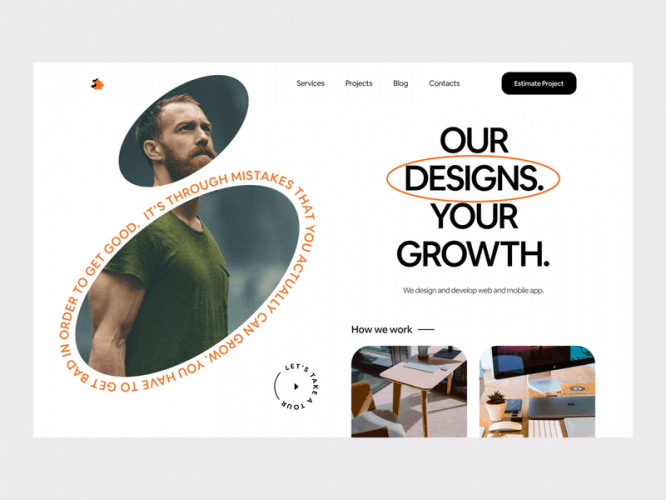10 key principles of UX design
There are many UX principles and laws that a designer must follow. In this article, we have selected a few rules that, in our opinion, are the most important and that we personally strive to regularly introduce into our work. These theories and principles were written not only by all famous designers such as Jakob Nielsen and Don Norman, but also by psychologists who have years of experience studying human interaction and behavior. Some of these principles were invented decades ago, but today they are still relevant, and many of them can be applied not only to design, but even to your daily life. Following these guidelines will help increase the chances of your UX being stunning! We decided to give only a summary of the principles with links to further study of each of them. Hopefully, this will make them more potent, easier to digest, and less controversial. Anyway, we hope so?

The 80/20 Rule, also known as the Pareto Principle, is a fascinating theory that says 20% of your efforts can produce 80% of results. This indicates that everything can be done more efficiently. We must focus most of our time on the critical moments from which we can get the most benefit. It was first identified in a study showing that 20% of the Italian population has 80% of the wealth. This theory can be applied to everything from sports to investments and even computer programming. For example, Microsoft noticed that by fixing 20% of computer bugs, 80% of problems would be fixed. Of course, this is only a rough estimate, sometimes the value approaches 90/10.

Aesthetic Usability Effect means that people often perceive visually attractive designs to be more intuitive and comfortable than one that is less pleasing to the eye. People are used to the fact that things that look better will work more efficiently. In most cases, clients will be more comfortable with minor issues if the design is aesthetically pleasing because of the positive emotional response they experience. It also fits with the Attractiveness Bias theory, which shows that we are drawn to beauty. This underlines how essential a well-tuned user interface is, combined with a solid UX.

Choice Overload is a principle of behavioral economics that states that in most cases, more choices do not always lead to better results. The idea is that as capabilities increase, complexity increases proportionally, and with it, usability and performance also decline. It often happens that a large number of options can cause confusion for clients, which in turn can lead to analytical paralysis, when a decision is not made at all. Choice overload has parallels with Hick’s Law, which explains that more choice leads to more effort and decision time.
As Ditar Rams said, “Less is better.”

Consistency is an important principle that is continually promoted by user advocates. This is such an important principle that it is even included in Don Norman’s “Design Principles” and Jakob Nielsen’s “Usability Heuristics for User Interface Design”. In a nutshell, the design should always match the interior elements within a particular design. Similar functions should use similar components to achieve similar goals. This indicates to the user that the end result will be similar to other design elements. This can sometimes be referred to as internal consistency. There are also external consistencies, which provide conventions in which people from the outside are used to detaching themselves from your design. In particular, how functions work in general. For example, an element that resembles a button should always be clickable and take you somewhere. Pressing the back button should bring us back. This is similar to the law introduced by Jakob Nielsen.

Goal-gradient Effect is a theory that states that people are motivated in proportion to their proximity to the final goal. Even more motivation comes when the end is clearly visible to the user, most people will even begin to move more persistently towards it. This can be easily seen on the example of discount cards: sometimes a seal has already been put or some fields have been filled in. This illusion of progress has been proven effective many times over. This is why it is important in interface design to show the status and progress of the user. For example, filling out a profile and progress bars. Otherwise, the user will be demotivated, and it is quite possible that he will never complete the task.

Ikea Effect is an interesting phenomenon that shows that people value what they have invested time in or created themselves. The theory is that the actual level of effort correlates with the amount of effort, that is, more effort leads to high value. This is why it is helpful, whenever possible, for users to invest their time in your product and design, allowing you to create and customize it. Even those long boring registration forms can be helpful if you take the time and make them more attractive. All the time you spend on your platform will increase your perception of value and increase user retention on your site.

Jakob’s Law on UX on the Internet, in fact, shows that familiar designs are always favored. The reason for this is that people are used to the way certain things work. However, when this law is violated. You can confuse users as it immediately creates a new experience to use, which in turn will frustrate people and likely lead to ignorance of your platform. Of course, innovation is important, especially if it has clear value. In most cases, however, it is best to keep the design familiar to the user and not reinvent the wheel.

KISS, which has nothing to do with kissing but is an acronym for Keep It Simple Stupid, clearly emphasizes that simple design works best. One of the reasons for this trend towards minimalism is that simple projects tend to be faster and cheaper to create and implement. They are more reliable and easier to maintain. Simplicity Theory also emphasizes this point – simplicity should always be preferred as it is the key to reducing clutter!

The essence of this theory is that we should use recognition, not remembering, because it is easier for us to recognize than to remember anything. For example, multiple choice is easier to answer correctly than a question that requires a short answer. Multiple choice already provides possible answers that awaken memory. Another example is to use pictures and icons instead of text, again because they are easier to recognize, similar to an image superiority effect. It also has to do with the sequential stance effect. The hypothesis is that even the position of an element in a group affects the accuracy of the memory. In most cases, people remember the first and last objects with more success than the rest. Sometimes this approach can be seen in restaurant menus, where prices for various products are strategically placed.

Social Proof is a fascinating theory that explains that we, as social beings, follow what others do and can easily be influenced and persuaded by other people, especially if they are in the majority. Product reviews, testimonials, expert advice and opinion leaders all provide insight into how this theory works. Any opportunity to add these types of social recognition techniques will increase the likelihood that people will stay on your platform as they are more likely to trust it.
Fusiform Face Area bears similarities to Social Proof: both of these theories show how much other people influence us, especially if they are looking or pointing to something in particular. Other things that really grab people’s attention are those that take us back to our primate ancestors. At that time, three things worried us most: can we mate with it, can we eat it, will it kill us? All these questions remain incredibly relevant and in our time and the answers to them can be constantly seen in advertising, using sexy images, delicious food or something shocking. So use any of these methods to get people’s attention!
Conclusion These theories are very important, try to stick to them whenever possible, even in your daily life. They are not always fully relevant to every aspect of design, so remember to run different user tests often … over and over and over again! Remember to focus on the business goals of the product and users, the aesthetics and prejudices you might have about design and UX in general.
Source: Design Glory


